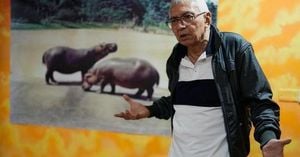For many pet owners, the anxiety of a missing animal is a nightmare that lingers in the back of their minds, a fear that can strike at any moment. In September 2025, two British families experienced the full spectrum of that fear—and the overwhelming relief of reunion—when their beloved pets returned home against all odds. The stories of Molly, a cockapoo lost in the wilds of North Yorkshire, and George, a tabby cat reunited with his family after nearly a decade, have touched hearts across the United Kingdom.
The first tale begins in the picturesque village of Pateley Bridge, North Yorkshire, where John Stringer’s two-year-old cockapoo, Molly, vanished during the August Bank Holiday weekend. According to reporting by the BBC and Metro, Molly’s disappearance occurred just after John had left for a holiday in Turkey. He was barely airborne when his mother called with the devastating news: Molly had escaped from her cottage.
“Just after I touched down in Turkey, I got a call from my mum in Pateley Bridge to say Molly had escaped,” John recounted to BBC News. The news triggered a frantic sequence of events. Despite being thousands of miles away, John wasted no time—he booked the next available flight home, desperate to help find his missing dog. The Stringer family, based in Leeds, was thrust into a week-long ordeal marked by what John described as “seven days of sleepless nights, of complete and utter panic.”
Help arrived in the form of Busters Animal SOS Team, a volunteer group specializing in tracking and rescuing lost pets. The group coordinated a search effort that drew support from residents across the Yorkshire Dales. Locals reported sightings of Molly, shared CCTV footage, and even helped set up cameras, bait, and humane traps. The search area expanded to include Gouthwaite Reservoir, where Molly had last been spotted.
According to Metro, the volunteers advised John and his daughter Emily, 16, to keep their distance from Molly when she was finally located. The team explained that frightened dogs can sometimes bolt if approached too quickly by their owners. Instead, the family was told to let Molly come to them. The plan worked. After days of careful tracking, Molly was finally coaxed back and, in a moment captured by drone footage, she bolted into the arms of John and Emily. The emotional reunion ended a week of worry and heartbreak.
“The volunteers were absolutely priceless,” John told BBC News. “I feel so lucky, in a way, that things happened [in Pateley Bridge]. The local people, I can’t thank them enough.” The footage of Molly’s return quickly made the rounds online, reminding viewers everywhere of the power of community and compassion in times of crisis.
While Molly’s week-long adventure had a happy ending, another family in Scotland was about to experience a reunion that seemed almost impossible. Fran Henriquez, her husband Billy, and their two children in East Kilbride, South Lanarkshire, had long given up hope of ever seeing their tabby cat George again. George, who had originally been a stray treated by the veterinary practice where Fran’s mother worked, had been a cherished member of the Henriquez household for four years before vanishing in 2016.
Fran and Billy did everything they could at the time—putting up posters, alerting neighbors, and searching nearby rural areas. “He was a cat that could go outside, but he would always be home for breakfast, no matter what. So when he didn’t appear we knew something wasn’t right,” Fran told BBC Scotland News. Despite a few false alarms, the family eventually assumed the worst, believing George had died.
But in early September 2025, Fran received a call that would upend all those assumptions. The Scottish SPCA, an animal rescue charity, had found a tabby cat fitting George’s description while collecting other animals in Glasgow. The cat was identified through a microchip, a small device implanted under the skin that stores the owner’s contact information. Fran was initially skeptical. “They phoned and said they had my cat and my first thought was ‘that’s weird, my cat is on the sofa right now’,” she told BBC Scotland News. “Then they said the microchip said his name is George and I thought ‘it can’t be him!’ It’s a bit of a miracle.”
Fran traveled to the charity’s Glasgow base, where she found George “more or less fine, save for some matted fur and bad teeth.” Now 14 years old, George quickly settled back into life with the Henriquez family. “He is exactly how we remember him. He’s friendly and gentle, and so relaxed at home,” Fran said. The reunion was especially poignant for the family’s elder child, who remembered George from before his disappearance. Their younger son, who had only heard stories of “poor George that went missing,” was thrilled to finally meet the cat in person.
The Scottish SPCA used the occasion to highlight the importance of microchipping pets. The charity continues to campaign for compulsory cat chipping in Scotland, arguing that George’s return is a powerful example of how microchips can bring families back together—even after years apart. For Fran, the reunion was bittersweet. “It’s a bit bittersweet as he is now an elderly cat and we have missed most of his life. But hopefully we can give him a really nice retirement.”
Both stories, published on September 16, 2025, underscore the resilience of hope and the vital role that communities and technology play in reuniting lost pets with their families. Whether it’s drone footage guiding a cockapoo back to her owner’s arms in the Yorkshire Dales or a microchip unlocking the mystery of a tabby’s nine-year odyssey, these reunions are a testament to the enduring bonds between humans and their animal companions.
As Molly and George settle back into their homes, their journeys serve as a reminder to pet owners everywhere: never underestimate the resourcefulness of volunteers, the power of collective action, and the quiet miracles that can happen—even after hope seems lost.





